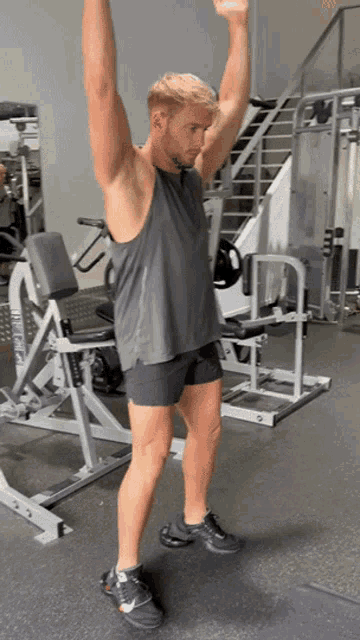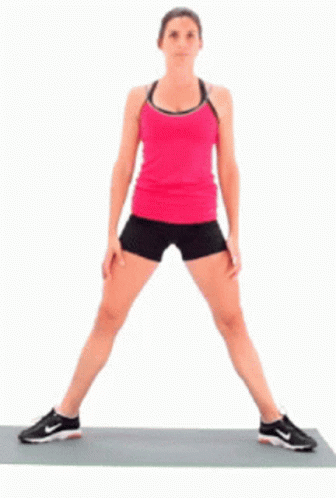Squat Mastery: Building Strength and Power (Full Body Workout).
Today's post is about squat mastery 
 In this comprehensive guide, we'll dive deep into the art of squatting, exploring the muscles involved, effective implementation strategies, and essential tips for maximizing your gains.
In this comprehensive guide, we'll dive deep into the art of squatting, exploring the muscles involved, effective implementation strategies, and essential tips for maximizing your gains. 
**Muscles Engaged in Squatting**
Squats are a compound exercise, targeting multiple muscle groups simultaneously. Here's a breakdown of the primary muscles involved:
* **Quadriceps:** The front of your thighs, responsible for extending your knee.
* **Hamstrings:** The back of your thighs, involved in flexing your knee.
* **Glutes:** Your buttocks, crucial for extending your hip.
**Implementation Strategies for Maximum Results With Squats**
1. **Proper Form:**
* **Foot Placement:** Position your feet slightly wider than your shoulders, toes slightly outward.
* **Bar Placement:** Rest the barbell on your upper back, just below your neck.
* **Depth:** Squat until your thighs are parallel to the ground or lower.
* **Back:** Keep your back straight and avoid rounding your shoulders.
2. **Progressive Overload:**
* Gradually increase the weight you're lifting over time to challenge your muscles.
* Use a variety of rep ranges (e.g., 5-8 reps for strength, 10-12 reps for hypertrophy).
3. **Squat Variation is Key:**
* Incorporate different squat variations (e.g., back squats, front squats, goblet squats) to target different muscle fibers and prevent plateaus.
4. Use Accessory Exercises To Complement Squats
* Complement your squats with exercises that target specific muscle groups involved in the movement, such as leg extensions, leg curls, and calf raises.
5. **Squat Nutrition and Recovery:**
* Fuel your body with a balanced diet rich in protein, carbohydrates, and healthy fats.
* Prioritize adequate sleep and rest to allow your muscles to recover and grow.
6. Easy Squat Tutorial For Beginners
The Starting Position:
- Feet: Stand with your feet shoulder-width apart. You can experiment with a slightly wider stance if it feels more comfortable, but shoulder-width is a good starting point. Your toes should point slightly outward (about 5-15 degrees).
- Posture: Stand tall with your chest up, shoulders back and down, and core engaged (imagine you're about to be punched in the stomach - that's the feeling you want).
- Arms: You can hold your arms straight out in front of you for balance, or place your hands on your hips.
2. The Descent (Going Down):
- Hinge at the Hips: This is the most crucial part. Initiate the movement by pushing your hips back as if you're about to sit in a chair. Think "hips back, then knees bend." Avoid bending your knees first.
- Knee Movement: As your hips move back, your knees will begin to bend. Keep your knees tracking in line with your toes. Don't let them cave inwards (valgus collapse).
- Depth: Aim to lower your hips until your thighs are parallel to the floor (or as close as you can comfortably get). This is a "parallel squat." If you can't reach parallel yet, that's okay! Go as low as you comfortably can while maintaining good form. As you get stronger, you'll be able to go deeper.
- Weight Distribution: Keep your weight on your heels and mid-foot. You should be able to wiggle your toes. Don't let your weight shift forward onto your toes.
- Back: Keep your back straight throughout the movement. Avoid rounding your back or arching it excessively. Imagine a straight line from your head to your tailbone.
3. The Ascent (Coming Up):
- Drive Through Heels: Push through your heels to return to the starting position. Imagine pushing the floor away from you.
- Engage Glutes: Squeeze your glutes (butt muscles) at the top of the movement to fully extend your hips.
- Maintain Posture: Keep your chest up and core engaged as you stand up.
4. Breathing:
- Inhale: Take a deep breath in as you lower into the squat.
- Exhale: Exhale as you stand back up.
Key Tips for Beginners:
- Start Slow: Focus on proper form over speed or weight.
- Practice: Practice makes perfect! The more you squat, the better you'll get at it.
- Use a Mirror: If possible, practice in front of a mirror to check your form.
- Start with Bodyweight: Don't add weight until you've mastered the bodyweight squat.
- Listen to Your Body: If you feel any pain, stop and rest. Don't push through pain.
- Progression: Once you're comfortable with bodyweight squats, you can gradually add weight using dumbbells, kettlebells, or a barbell.
Troubleshooting:
- Knee Pain: If you experience knee pain, it could be due to improper form, weak glutes, or tight hip flexors. Try adjusting your stance, strengthening your glutes, and stretching your hip flexors.
- Rounding Back: This is a common mistake. Focus on keeping your chest up and core engaged. You can also try practicing with a dowel rod across your back to help maintain a straight back.
- Falling Forward: This indicates that your weight is shifting forward onto your toes. Focus on keeping your weight on your heels.
This tutorial should give you a good foundation for learning how to squat correctly. Remember to be patient with yourself and celebrate your progress along the way!


